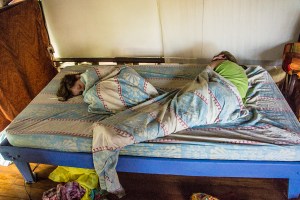 We sleep better without the tropical storm. The mosquito bites are driving us crazy. We estimate there are 200 bites between the four of us.
We sleep better without the tropical storm. The mosquito bites are driving us crazy. We estimate there are 200 bites between the four of us.
Trish is pretty cranky. She doesn’t usually get mosquito bites – they prefer me. But this time they have attacked her relentlessly. It looks like a disease.
It’s our last day of Corcovado. Trisha and I have to encourage the girls to do our last hike, a 2 miler through the old growth forest. Lily and Emma shuffle through the hike and ask ‘Are we there yet’ every 5 minutes.
 The Primary forest
The Primary forest
Most coastal forest in the Americas (and anywhere else) was logged to feed the needs of the growing industrial economies. Although some of what is now Corcovado was logged, most of it is still primary forest. In fact it’s the largest coastal primary forest on the American Pacific coastline and one of the largest coastal rainforests in the world.
 Most of our hikes have been in the secondary forest along the coast near the Sirena ranger station, which was cow pasture in the 1960’s before it was converted to a National Park.
Most of our hikes have been in the secondary forest along the coast near the Sirena ranger station, which was cow pasture in the 1960’s before it was converted to a National Park.
Animals tend to congregate along the beachfront, so it’s still the best place for seeing them.
But the Primary forest is darker and higher. The canopy is a hundred feet up and it’s much darker near the ground. Kenneth points out some magnificent trees. I’m a big fan of trees. These are amazing.
 One in particular, a strangler fig that killed it’s host and survives as a wooden cage, a hundred feet high. Strangler figs begin as vines, and grow up existing trees to reach the sunlight at the canopy. They sometimes kill the host and remain self supporting.
One in particular, a strangler fig that killed it’s host and survives as a wooden cage, a hundred feet high. Strangler figs begin as vines, and grow up existing trees to reach the sunlight at the canopy. They sometimes kill the host and remain self supporting.
This one is big enough to climb into and through. Kenneth advises us to check for snakes inside first, which makes us all a little leery of going in too deep.
 Dead Monkeys tell no lies
Dead Monkeys tell no lies
Startled is my reaction at seeing a small child skeleton on the jungle floor. Of course it’s a monkey skeleton, Kenneth laughs. It died about three months ago, most likely from a cat.
 We haven’t been able to see any Puma, Leopard or Ocelots although Corcovado is one of the last strongholds for those predator cats in North America. Cats are the prize sighting, but we saw an armadillo, which is actually even rarer.
We haven’t been able to see any Puma, Leopard or Ocelots although Corcovado is one of the last strongholds for those predator cats in North America. Cats are the prize sighting, but we saw an armadillo, which is actually even rarer.
 There are four types of monkeys in Costa Rica, and they are all four here in corcovado. The only one we didn’t see (or hear) is the capuchin or white-faced monkey. The howler is easy to hear but a little difficult to spot. Kenneth finds one way up in the canopy.
There are four types of monkeys in Costa Rica, and they are all four here in corcovado. The only one we didn’t see (or hear) is the capuchin or white-faced monkey. The howler is easy to hear but a little difficult to spot. Kenneth finds one way up in the canopy.
 Leaving Corcovado
Leaving Corcovado
Our gear is stuffed back into the backpacks, and we eat one last meal. The Creekmores are ready to go. Corcovado has been challenging. The mosquitos and heat are the worst, but the hiking is exhausting. We’ve gone 15 miles in the last 48 hours. We will remember it as our best rainforest adventure.
After a 60 minute boat ride back to the main town we are ready for a shower and some real food. Kenneth has a little trouble with our hotel reservation and needs to book us another place. “Is this one okay” he asks, as we drive up. “As long as it has a shower” Trish impatiently answers. She has gone from cranky to seething in the past few hours. This isn’t going to end well if we don’t get her a shower soon.
 It’s a nice room, but they only have one bed for the kids, a public bathroom and a cold shower. Sigh. We’ll be in good hands tomorrow when we get to Arenal, but comfort will elude us for one more day.
It’s a nice room, but they only have one bed for the kids, a public bathroom and a cold shower. Sigh. We’ll be in good hands tomorrow when we get to Arenal, but comfort will elude us for one more day.
Even the cold shower helps our mood. Dinner is decent at the local soda and there is a good ice cream stand that makes the kids happy before they go to bed.
